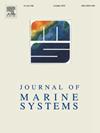西南大西洋生产性陆架生态系统中与海洋学条件相关的水母生物量时空变异
IF 2.5
3区 地球科学
Q2 GEOSCIENCES, MULTIDISCIPLINARY
引用次数: 0
摘要
本研究首次对西南大西洋一个高产和经济意义重大的海洋区域内的大型远洋刺胞动物(Aequorea forskalea)进行了大规模的长期生态评估。利用近30年夏季渔业调查数据(1995-2024),分析了黑鲈生物量的时空变异及其与海洋条件的关系。生物量分布具有空间结构,主要集中在San Jorge Gulf,这是一个具有时间持久性的生物量热点。2011年发生了重大转变,标志着从高生物量阶段(1995-2010年)向低生物量阶段(2011 - 2024年)过渡,与热点地区底部温度上升和盐度降低相一致。鉴于阿根廷鳕鱼和巴塔哥尼亚红虾等主要渔业物种早期生命阶段的时空重叠,Aequorea可能会通过捕食和竞争影响物种的补充动态。这些发现强调了整合生物和物理数据来理解凝胶状浮游动物动力学的重要性。长期渔业调查显示是基线数据的宝贵来源,对于预测生态系统对环境变化的反应至关重要。本文章由计算机程序翻译,如有差异,请以英文原文为准。
Spatio-temporal variability in medusa biomass linked to oceanographic conditions in a productive shelf ecosystem of the Southwestern Atlantic
This study presents the first large-scale, long-term ecological assessment of a large pelagic cnidarian (Aequorea forskalea) within a highly productive and economically significant marine area of the Southwestern Atlantic. Using nearly three decades of summer fishery survey data (1995–2024), we evaluated the spatial and temporal variability of Aequorea biomass and its relationship with oceanographic conditions. Biomass distribution was spatially structured, concentrating in the San Jorge Gulf, a temporally persistent hotspot of biomass. A major shift in biomass occurred in 2011, marking a transition from a high-biomass phase (1995–2010) to a period of low biomass (2011–2024), coinciding with rising bottom temperatures and decreasing salinity in hotspot areas. Given the spatio-temporal overlap with early life stages of key fisheries species (Argentine hake and Patagonian red shrimp), Aequorea may influence recruitment dynamics through predation and competition. These findings underscore the importance of integrating biological and physical data to understand gelatinous zooplankton dynamics. Long-term fisheries surveys are shown to be valuable sources of baseline data, essential for predicting ecosystem responses to environmental change.
求助全文
通过发布文献求助,成功后即可免费获取论文全文。
去求助
来源期刊

Journal of Marine Systems
地学-地球科学综合
CiteScore
6.20
自引率
3.60%
发文量
81
审稿时长
6 months
期刊介绍:
The Journal of Marine Systems provides a medium for interdisciplinary exchange between physical, chemical and biological oceanographers and marine geologists. The journal welcomes original research papers and review articles. Preference will be given to interdisciplinary approaches to marine systems.
 求助内容:
求助内容: 应助结果提醒方式:
应助结果提醒方式:


